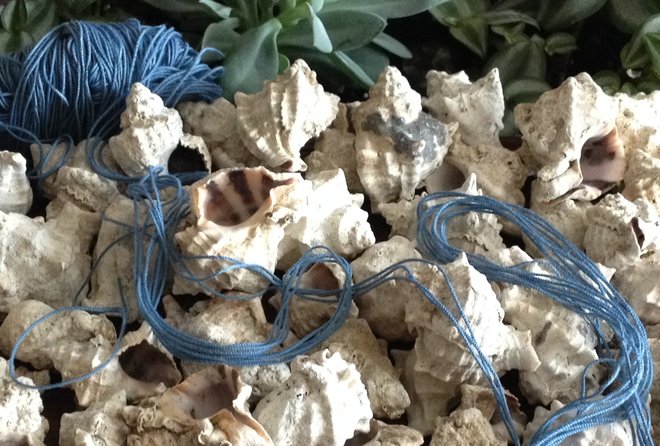 For more than 3000 years, Jews dreamed of recovering a lost blue dye called techelet. Using clues laid down over 100 years ago by one rabbi in Poland, and another in Israel, Ptil Techelet, the Association for the Promotion and Distribution of Tekhelet, has succeeded in tracking down the dye’s source and reviving it. We’ve posted on another Jewish revival, one a bit earthier: Jewish beer.
For more than 3000 years, Jews dreamed of recovering a lost blue dye called techelet. Using clues laid down over 100 years ago by one rabbi in Poland, and another in Israel, Ptil Techelet, the Association for the Promotion and Distribution of Tekhelet, has succeeded in tracking down the dye’s source and reviving it. We’ve posted on another Jewish revival, one a bit earthier: Jewish beer.
Jews are Biblically commanded to wear ritual fringes – tsitsit – “on the corners of their garments.” The Biblical passage continues: “And God said to Moses, say to them that they shall place upon the tsitsit of each corner a thread of techelet (a rich blue color). And you shall see it and remember all the commandments of God…”
In ancient times, a blue techelet thread was knotted among white ones, as described to Moses. To fulfill the commandment of tsitsit, Jewish men throughout the ages have worn a short, four-cornered wool or cotton shift with ritual fringes attached to each of its corners. At given times during prayer, or at any time, a man holds the tsitsit up and looks at it, to remind himself that his actions should be imbued with holiness. This distinctive blue thread was the reminder.
 Although indigo and woad plants also yield blue dyes, only dye from a sea animal is considered the legitimate source of color for the blue thread. While other Murex varieties yield purples and reds, only Murex trunculus yields sky-blue techelet.
Although indigo and woad plants also yield blue dyes, only dye from a sea animal is considered the legitimate source of color for the blue thread. While other Murex varieties yield purples and reds, only Murex trunculus yields sky-blue techelet.
Along the northern coast of Israel and up into Lebanon, dyeing houses took in harvests of the sea snail and cooked them for many days in salted water with fenugreek; or in urine. Near Tyre, archaeologists have found large mounds of snail shell remains, indicating where local dyeing industries flourished in Biblical times. Remains of the techelet snail have also been found on Mt. Zion, Jerusalem, indicating an ancient dyeing industry there.
Techelet was an expensive dye, obtained through a labor-intensive, long-drawn-out hand process that yielded the blue coveted by Jews and Gentiles alike. Fabrics dyed this color, along with purple and crimson, were as valuable as gold. Dye from marine snails and its attendant industry were so important that images of the Murex snail were imprinted on a number of Roman coins. Below is one showing a Roman eagle with the Murex snail between its claws.
Ancient Roman and Greek ruling classes adopted sumptuary laws to enforce privilege and social distinction, making it illegal for anyone but themselves to wear blue, purple, or crimson clothes. The Roman governments eventually monopolized the dyeing industry. Jews were consequently forbidden to produce techelet. The Muslim conquest of Israel in the 7th century brought new prohibitions against the manufacture of techelet. As the Jewish dyeing houses closed, the secret to making techelet was lost.
But the dream was never totally abandoned. In 1889, the head of a Polish hassidic sect, Rabbi Gershon Henoch Leiner, traveled to Italy and witnessed blue dye being made from the black ink secreted by cuttlefish. The ink was boiled together with iron filings and a form of potassium. Rabbi Leiner was convinced that he had discovered the source of the techelet. Some say that the rabbi was fooled by an Italian chemist who saw a chance to cash in on a new market, because any organic material takes on a blue dye when boiled with iron filings. In any case, his theory was rejected by all but his own followers.
The next investigation into techelet was undertaken by Rabbi Isaac Herzog in 1913. In his scientific doctoral thesis, the Jerusalem sage claimed that the authentic source of techelet is the Murex trunculus snail, basing his theory on its discovery by French zoologist Henri Lacase Duthiers, in 1857. Below is a page out of Rabbi Herzog’s thesis.
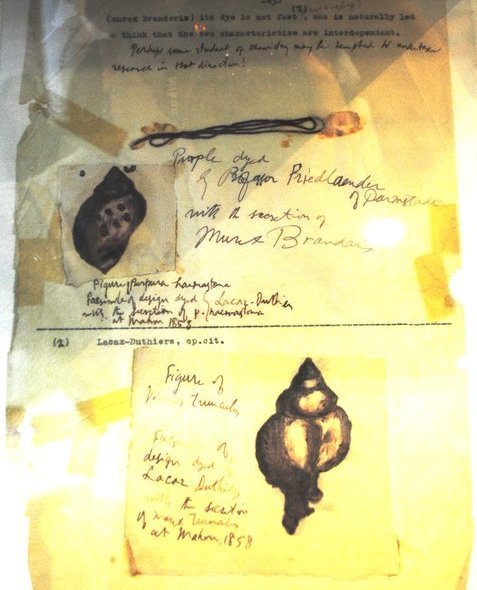 Handwritten 100 years ago at the top of the page is this remark: “Perhaps some student of chemisty may be tempted to undertake research in that direction!”
Handwritten 100 years ago at the top of the page is this remark: “Perhaps some student of chemisty may be tempted to undertake research in that direction!”
Under the right processing conditions, the snail’s digestive gland produces a rich sky blue color. The snail itself has all the physical markers described in the Talmud. The Ptil Techlet organization has proved Rabbi Herzog’s theory to be correct.
Ptil Techelet held a conference celebrating 100 years of techelet research this week in Jerusalem. Speakers and panelists included scientists, archaeologists, historians, a specialist in ancient languages, and prominent rabbis.
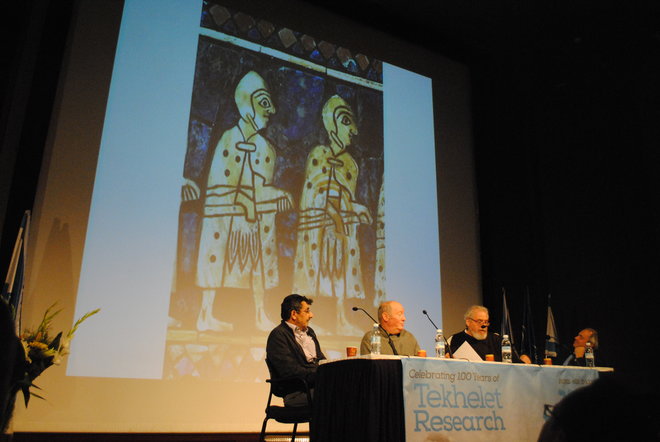 From left to right: Prof. Zohar Amar, Dept. of Archaeology, Bar-Ilan University; Prof. Ilan Sharon, Dept. of Archaeology, Hebrew University; Prof. Horowitz, Faculty of Science, Hebrew University, and Dr. Baruch Sterman, a founder of Ptil Techelet. The founders of Ptil Techelet described their search for Murex trunculus, how they tested ancient harvesting methods and recreated the ancient cooking process themselves. There was a live demonstration of the dyeing process.
From left to right: Prof. Zohar Amar, Dept. of Archaeology, Bar-Ilan University; Prof. Ilan Sharon, Dept. of Archaeology, Hebrew University; Prof. Horowitz, Faculty of Science, Hebrew University, and Dr. Baruch Sterman, a founder of Ptil Techelet. The founders of Ptil Techelet described their search for Murex trunculus, how they tested ancient harvesting methods and recreated the ancient cooking process themselves. There was a live demonstration of the dyeing process.
It was thrilling to see the techelet actually forming itself under our own eyes. Although the salty, rotten smell was less than pleasant, it brought a feeling of experiencing the same exact thing that ancient people did.
Ptil Techelet is researching ways to farm the Murex trunculus snail, in order to establish a sustainable way of continuing production. They are concerned with issues of over-fishing and preservation of the snail for future generations.
This, then, is techelet.
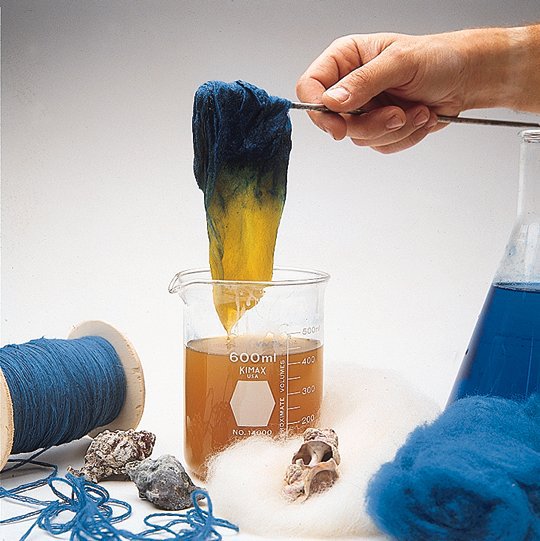 More on Jewish traditions from Green Prophet:
More on Jewish traditions from Green Prophet:
- Tu B’Shvat, The Jewish New Year For The Trees
- First Etrog Tree In Holy Land Discovered In Jerusalem
- Traditional Jewish Burial Rites Are Green
:: www.tekhelet.com
Ptil Tekhelet is also on Facebook

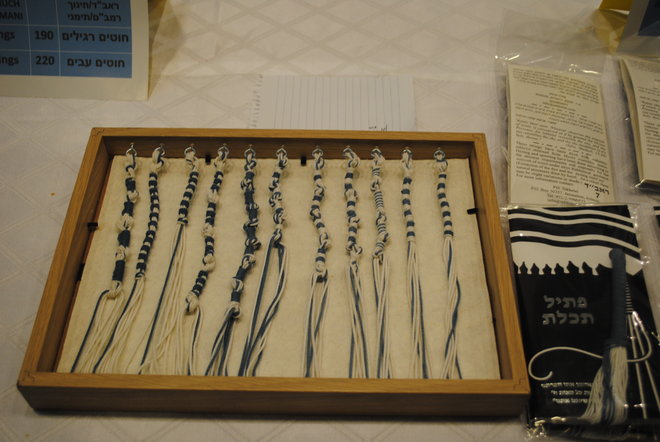 And why blue? Jewish sources say that blue, reflecting the color of the sky, reminds one of God’s heavenly throne. Regarding it keeps one’s thoughts focused on holiness. The blue dye was obtained from the digestive gland of a particular marine snail, Murex trunculus.
And why blue? Jewish sources say that blue, reflecting the color of the sky, reminds one of God’s heavenly throne. Regarding it keeps one’s thoughts focused on holiness. The blue dye was obtained from the digestive gland of a particular marine snail, Murex trunculus. 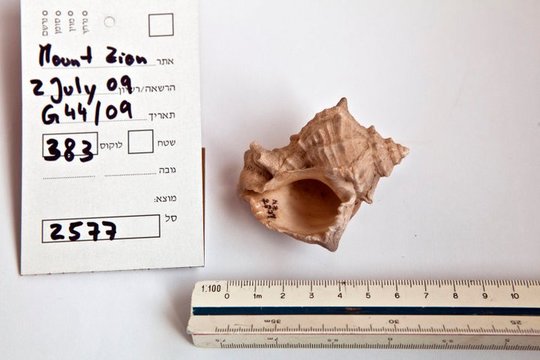
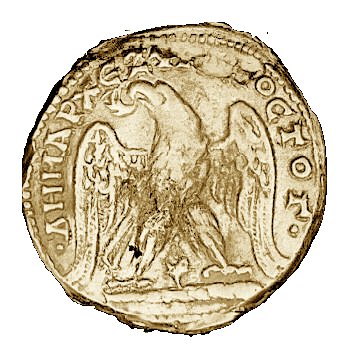
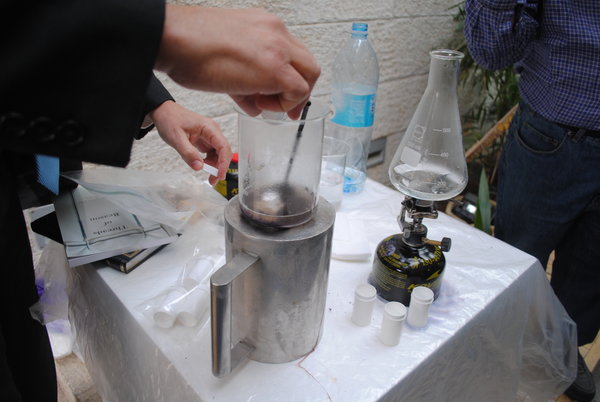


Snails are unclean (tamei), which would have to make it an exception in the sense that it would be the only inconsistency of purity in all the commands given regarding the holy service to the Elohim of Moshe. He calls Himself the holy Elohim, and if you are to approach Him, you must be holy. That which is tamei, by default, would be disqualified, for nothing unclean may come before His presence, lest it be burned away to nothingness. In the times of the ancestors, no one would dare consider offering swine on the alter of His temple – it simply wasn’t an option.
If it would be inappropriate to bring a pig before Him, how is it acceptable to use a snail and urine as a means to color the very cord that’s supposed to remind us of the *holy* Elohim? If the high priests were supposed to don tzitzot like anyone else of His people, would it not be a problem for the high priest to come before the King of the universe with something unclean on his clothes, when he is commanded to appear before Elohim *clean* in every regard?
I encourage caution before accepting these conclusions. It does not seem good to put uncleanness on HaShem. Surely there’s a better way to honor Him.
Ari Greenspan comments that it is perfectly clear that tekhelet is the sky blue of indigo. If only it were that clear to the Rishonim. Ibn Ezra (Shemot 25:4) and Rashi (Sota 17a) say that tekhelet only slightly resembles the sky. Tosafot (Chulun 47b) says that indigo is like the color of the sky and slightly resembles tekhelet. Perhaps this is why the Radzyner Rebbe chose to make royal blue over sky blue, though he could make either using the same process depending on the proportion of the ingredients.
What is unclear to me is why this new fabric analysis is trumpeted as being tekhelet and proof that tekhelet is sky blue from Murex trunculus.
1. The fabric is not tzitzit, and so there is no tekhelet.
2. The color is not sky blue. It is identified as blue-greenish in the presentation at the conference. No mention is made of the origin of the greenish tint – are there yellow coloring components? (the one thing I remember from art class as a kid is that blue+yellow=green).
3. The fabric analyzed by Dr. Zvi Koren is described by him as purplish blue (he holds tekhelet is blue purple), and by Ptil as midnight blue (sounds like a sky blue). But it is definitely NOT the sky blue of indigo. And again, it is merely fabric. Not tzitzit, not tekhelet.
4. Both analyses are incomplete. They both look for tiny traces of monobromoindigo and dibromoindigo, the tell-tale signs of murex dye – which is what they are trying to find. Neither has made any effort to check for traces of something that would be a tell-tale sign of plant indigo, since this is not what they want to find. Perhaps both fabrics are dyed with plant indigo and there are merely microscopic traces of murex dye because murex dyeing was done in the same location? Maybe they reused the same vat, or it was just around and there was a sort of tiny, tiny cross-contamination. When the amounts are so incredibly tiny (as Baruch Sterman of Ptil Tekhelet acknowledges with Dr. Koren’s analysis – parts per million?), it is not at all clear it was in fact dyed with murex.
5. While k’la ilan is identified as indigo by the Aruch, it is not clear if it is just indigo or a blend of indigo with something else to mimic the color of tekhelet.
Despite Ptil Tekhelet’s efforts to once again spread the word that authentic ancient tekhelet was found, it is simply not true.
I am quite puzzled by some of the positions adopted by noted Ptil Tekhelet leaders in the comments here. Mois Navon has researched and written extensively on the subject, so it is hard to understand why he makes some of the comments he did when the answers are in the main sources on the subject of tekhelet.
1. The mystery of the mounds. The answer to this mystery was given almost 2,000 years ago – it is recorded by Pliny the Elder. He explains that Thais haemastoma and Murex brandaris were used to double-dye to make the famed Tyrian Purple. Murex trunculus was used to dye its natural blue-purple. Accordingly, we find the two mounds matching up with that explanation. Pliny the Elder’s description of murex dyeing is the primary source we have on the subject, and the Ptil Tekhelet Foundation commonly references it. As such, it is extremely puzzling why Mois, and others from the Ptil Tekhelet Founation, persist in making their claim that murex trunculus was in a separate mound because it was used to dye blue.
2. Mois says he is sad that people continue to consider the cuttlefish (Sepia officinalis) as the chilazon. Surely he realizes that people say the same thing about the murex. His comments in that paragraph are just 100% wrong. The cuttlefish ink is not completely burned off – it is broken down and needed for the dye. The claim against it is that other organic substances would also work. That the Rebbe would today reject his claim about the cuttlefish is foolish. Surely Mois is familiar enough with the Rebbe’s work to know that he first established the rules for identifying the chilazon, and upon finding that the cuttlefish met these criteria, he proclaimed it the chilazon BEFORE he had figured out a dye process. At the very worst, even if the dye process is completely discredited, Radzyn is back to the point in time when the Rebbe declared the cuttlefish to be the chilazon. In other words, the dye process issues have nothing to do with identifying the chilazon – according to the Radzyner Rebbe. Of course, one can differ with the Radzyner’s approach, but he has one huge advantage (besides being one of the greatest Talmudic scholars of the 19th century – consider his Sefer Sedrei Taharos pseudo-Gemaras on seder Niddah) – he worked out the rules for identification BEFORE he started his search. They were unbiased. If he considered the cuttlefish the chilazon without any idea of a dye process, he would still consider it the chilazon with his process discredited. Except his dye process may still be kosher, even if not the original process. If the cuttlefish is the chilazon, and you start with dam chilazon and end up with tekhelet, it is likely kosher tekhelet even with a new, modern process not unique to the cuttlefish. Even Ptil uses a process that couldn’t be done in ancient times, but it is expedient and obtains the same result. One can certainly argue with the Radzyner’s approach to identifying the chilazon, but it is consistent, unbiased and unaffected by claims about the dye process.
I had thought about buying some tekhelet, but after reading some of the material on the Internet and listening to Rabbi Reisman’s shiur, I decided to hold off.
What I would REALLY like is if Rabbi Reisman and someone behind the Ptil Tekhelet would debate. It would answer many of the questions I have and it would allow people to make up their minds. There are too many questions!
Mois, the response you made about the Gra and how everything is a fish is a very weak argument.
Mois,
It is indeed sad to read that people still cling to the mounds theory. Rabbi Yisroel Reisman makes an excellent point in his indepth rejection of Murex (http://www.yutorah.org/lectures/lecture.cfm/761970/Rabbi_Yisroel__Reisman/Techeles_Hachodosh#). Unless there is a sign over the mounds saying “buy your Mois Talit here”, Rabbi Reisman says the argument is absurd and the pictures of the caves are “just to fool people”.
Rav Reisman also agrees that the Sepia is not the chilazon.
Rav Reisman says that if the molecules are the same, it is invalid.
The word used was the FORM of a fish. Not a snail. I know the Gra, but as Rav Reisman says “from teruzim you don’t make halacha”. LOL, my bubbie used to call all vehicles cars. If my city’s firefighters send experts to negotiate the purchase of a fleet of new firetrucks, and come home with a bunch of ice cream trucks there is a problem…
Rav Reisman investigated the claims and exchanged letters with the people behind the murex techelet, sums up that it is a ZERO percent chance of being the real chilazon.
“After a lot of iyun and efforts and correspondence…there is a ZERO percent chance that the Rambam held that it is the chilazon…”
In response to “Freind of GP” below – here are some answers – all of these points have been dealt with in detail in my book “Threads of Reason”. For those interested in investigating the topic are invited to send me an email to obtain a copy: [email protected]
1. R. Herzog brings the archeological find of massive mounds of broken snail shells and notes that there were actually 2 massive mounds – one consisting of Murex brandaris and Thais haemastoma and a second consisting of only Murex trunculus. R. Herzog, like the archeologist Alexander Dedikind, concludes that the ancients must have been sorting them according to color usage – that is, one mound to make one color and the other mound to make a different color. Given that these snails all produce colors from blue to purple, it is more than reasonable to assume that one was for purple and one for blue. Now, while it is possible to get either blue or purple from any of the three snails depending exposure to the sun while in the dye vat – the Murex trunculus has more blue naturally even before exposure to the sun and thus it is believed that it was used for tekhelet. Nevertheless, any one of the three could be used for tekhelet since the Gemara doesn’t specify which snail be used, but only that a sea snail be used. And of course any one could also be used for argaman (purple) by developing the dye in the shade.
2. It is indeed sad to read that people still forward the Sepia officinallis as candidate for the hillazon. It has been shown without a doubt that the black ink from the sepia is burned off and has absolutely nothing to do with the blue color produced by the Radziner formula which is simply the formula for Prussian blue – a synthetic de which gets its blue from iron filings in the mix. The reason I say that it is sad people promote the Sepia o. is because the Rebbi himself said that the blue must come from the hillazon and not the additives – he was clearly unaware of this fact and would unquestionably reject his own formula as such.
3. The test today would have the same effect on Murex tekhelet and the plant indigo, and that is that both PASS the test! However, in ancient times the processing of the plant was done in such a way that it did not take as well to the wool.
4. The Talmudic source refers to the hillazon as being “similar” to a fish – not being a fish. In any case, the Vilna Gaon notes that everything it the sea is referred to as “a fish”. 70 years is a metaphor for once in a lifetime. Maimonides did not enumerate 70 years among the criteria for the hillazon as he understood it as is, a metaphor.
As one of the discoverers of this dye in recent years, one thing can be said: This is without a doubt the source of the ancient purples and blues of Rome and the Talmud. The scholarly debates of exactly which shade of blue/purple /violet are exactly that, debates on the hallowed halls. The reality of dying wool leaves no doubts, the color is a sky blue indigo.
You might want to see http://www.tekhelet.com for more info. check out the extensive library.
Rawlinson wrote: The “purple” dye which gave to the textile fabrics of the Phoenicians a world-wide reputation was prepared from certain shell-fish…
Rawlinson’s “extensive” writings are speculative when it comes to the blue:
…”appear” to have ranged from…
…owed its beauty “probably” to Tyrian dyers and Tyrian workers in embroidery.
Rawlings gave comparative descriptions of two species of shellfish including the including the Murex trunculus, the same genus mentioned in this “new” discovery. He even described how the dye was contained in a sac behind the head as a colorless, creamy solution. He went on to point out that when carefully extracted and applied to wool, linen or cotton and exposed to light that it produced colors ranging from green to blue to purple to crimson. He also noted that these shellfish were not confined to a specific locality and knowledge of the dyes property was known to many nations. He even mentions that Aristotle wrote descriptions of this shellfishes egg sacs and described how they mate and the typical depths at which they are found. He then described the seasons during which they were collected so they would hold the greatest amount of the dye. He goes on to describe how the dye was then obtained from the harvest and used. In all he devotes about 10 pages of the book to the subject of the dye. Is that “extensive” enough. There is nothing “new” about this discovery with respect to how the Ancient Hebrews made and used the dye on their clothing. i
George Rawlinson published his book in 1889, about 2,000 years after the Phoenicians disappeared. Rawlinson’s “extensive” writings depended on other sources, which he clearly qualified:
“Concerning the Phoenician process of dyeing, the accounts which have come down to us are at once CONFUSED and INCOMPLETE.” (emphasis mine)
You wrote: “it produced colors ranging from green to blue to purple to crimson…”
That is NOT what Rawlinson wrote! The correct text is:
“The actual tints produced from the shell-fish APPEAR to have ranged from blue, through violet and purple, to crimson and rose.” (emphasis mine)
You left out the key word “APPEAR”. Don’t bring a source and misquote.
I didn’t use the word APPEAR (emphasis yours) for the same reason I didn’t use the words apple pie and Chevrolet, because it ISN’T THERE (emphasis mine). Rawlinson didn’t use it. It’s clear now that you haven’t read the book. You APPEAR to be quoting some critic of the book without knowing for yourself what was actually in it or perhaps your just making things up..
1. The author’s name was George Rawlinson, NOT George Rawlings.
2. You are quoting from The Story of Phoenicia (also called Phoenicia: History of a Civilization), which was part of a series called The Story of the Nations, published in 1889. The Story of Phoenicia was a mass market book published by G.P. Putnam’s Sons for the man on the street and probably children. No sources, just a pretty picture of life in different civilizations. They also published Herodotus for Boys and Girls, Plutarch for Boys and Girls, Pliny for Boys and Girls and more.
3. I am quoting from The History of Phoenicia, Rawlinson’s scholarly work, which is a substantially longer book and is fully referenced with hundreds of footnotes. In it he wrote: “The actual tints produced from the shell-fish APPEAR to have ranged from blue, through violet and purple, to crimson and rose.”
4. I would say that his scholarly work is probably a more accurate source than Murex for Boys and Girls.
In his book ” Phoenicia History of a Civilization” George Rawlinson wrote extensively about Murex Trunculus and it’s use by the Phoenicians in making blue dye. He wrote the book in …….1889.
The idea of scientists and bible scholars rediscovering a lost technology is very exciting. With the world getting smaller and new discoveries being made all the time in science and technology, it is fascinating to see the intersection of science and religion. Thanks for covering this story! The report needs a few additional explanations.
1. The reason archeologists have found large mounds of snail shell remains is because Murex Trunculus was commonly used for dyeing the biblical Argaman (purple) which, as noted, was extremely valuable. There is no clear evidence that Murex was the source of the Tekhelet used for the fringes of prayer shawls. The tradition in Judaism is that one family was involved in the dyeing of Tekhelet and they did not share this secret with anyone else. If Murex was used to make Tekhelet, having large mounds of snail shells would have been a real giveaway of their valuable trade secret (there were no IP lawyers back then).
2. Although Rabbi Leiner may have adopted a method for making Tekhelet that used the Sepia Officinalis as an organic material, his identification of the Chilazon, which is required to be used for making Tekhelet, was probably more correct than the Murex. The method used to make the Tekhelet is not as relevant as the source.
3. The Talmud warns about wearing fake Tekhelet (made from Indigo), which looked identical to authentic Tekhelet (made from a fish) and devised a test in order to distinguish between the two. The Tekhelet made from a Murex snail would fail that test, because it is chemically identical to Indigo.
4. The knowledge that Tekhelet has to be made from a sea creature comes from the Talmud. Throughout the Talmud and in the writings of scholars are references to the fish that is the source of the dye. These clues include the requirement that it should have the form of a FISH (not snail), surface every 70 years, look like the sea, have black blood (Maimonides), effective treatment for hemorrhoids etc. The Murex does not answer these requirements in a clear and simple manner, so it is not likely the source of the dye.
With the world getting smaller and new discoveries being made all the time in science and technology, the truth will likely be discovered soon and the mystery will be solved.